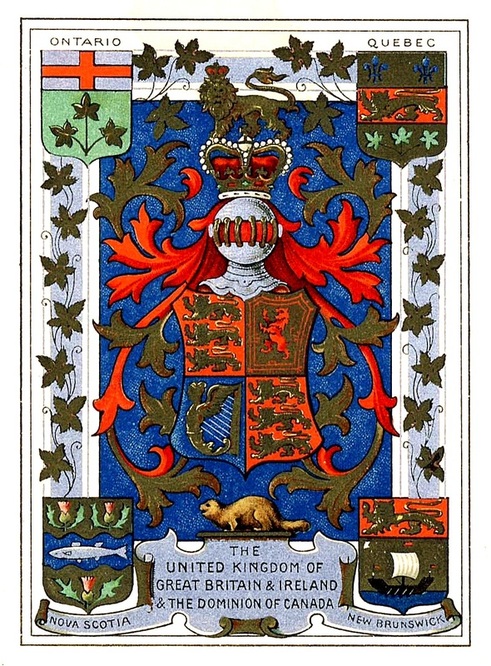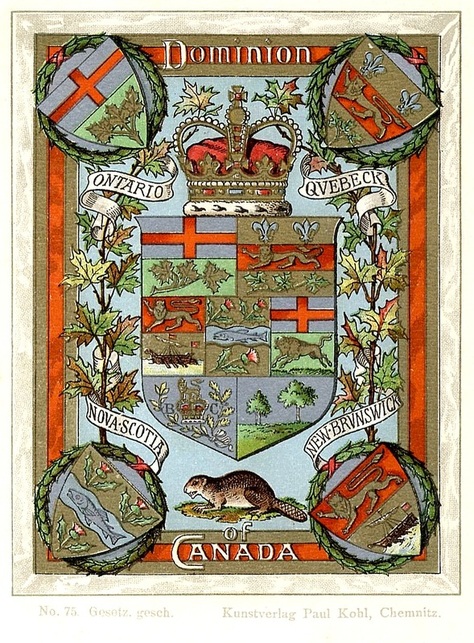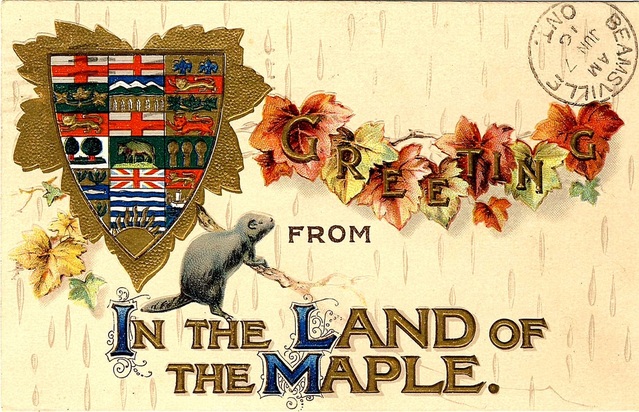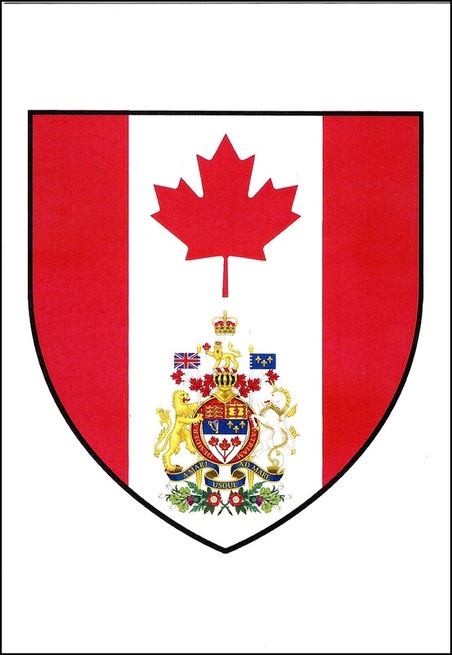A “The More the Merrier” Expression of Canadian Patriotism / Le patriotisme canadien selon la formule « plus il y en a, mieux c’est »
A “The More the Merrier” Expression of Canadian Patriotism
In former times during celebrations such as royal visits, Canadians represented Great Britain with all the flags they could reasonably associate with that country and frequently added the royal arms to the pageant. Perhaps the most important aspect of these patriotic manifestations is not that we can point to a number of improprieties in flag etiquette, but that they reflect the mentality of a period very much focussed on Great-Britain where a majority of Canadians found their roots, traditions and aspirations. As Canada began to acquire its own emblems, mother country and Canadian emblems were often combined to create very busy designs (fig. 1 & 2). Other compositions favoured Canadian content only, but sometimes with every Canadian symbol that could be enlisted (fig. 3 & 4).
In former times during celebrations such as royal visits, Canadians represented Great Britain with all the flags they could reasonably associate with that country and frequently added the royal arms to the pageant. Perhaps the most important aspect of these patriotic manifestations is not that we can point to a number of improprieties in flag etiquette, but that they reflect the mentality of a period very much focussed on Great-Britain where a majority of Canadians found their roots, traditions and aspirations. As Canada began to acquire its own emblems, mother country and Canadian emblems were often combined to create very busy designs (fig. 1 & 2). Other compositions favoured Canadian content only, but sometimes with every Canadian symbol that could be enlisted (fig. 3 & 4).
Fig. 1 This plate mixes Canadian emblems with those of Great Britain. It makes strong Canadian statements with the central medallion inscribed “CANADA OUR COUNTRY” and decorated with maple leaves, the beaver chewing on a branch of maple at the top, the inscription on a scroll below the medallion, “THE MAPLE LEAF FOREVER,” a song composed by Alexander Muir. Great Britain is represented by roses, thistles and shamrocks around the medallion, the Union Flag (Jack), the White Ensign of the Royal Navy, the Red Ensign of the Merchant Marine, and the Royal Standard, the sovereign’s personal banner. The royal arms are visible at the bottom. Plate by William Lowe, England, c. 1899. Vachon Collection, Canadian Museum of History.
Fig. 1 Cette assiette mêle des emblèmes canadiens à d’autres de la Grande-Bretagne. Le message canadien est accentué par un médaillon central inscrit « CANADA OUR COUNTRY » et décoré de feuilles d’érable, un castor qui ronge une branche d’érable dans le haut, l’inscription sur un listel sous le médaillon « THE MAPLE LEAF FOREVER », chanson composée par Alexander Muir. La Grande-Bretagne est représentée par des roses, des chardons et des trèfles autour du médaillon et quatre drapeaux : l’Union Flag (Jack), le White Ensign de la marine royale, le Red Ensign de la marine marchande et le Royal Standard, bannière personnelle du souverain. Dans le bas figurent les armoiries royales. Assiette par William Lowe, Angleterre, vers 1899. Collection Vachon, Musée canadien de l’histoire.
Fig. 2 In centre is the shield of the United Kingdom with its lion crest. Below the shield is a beaver. The shields of the original provinces to join the Canadian Confederation occupy the four corners. The leaves in the margin on vines are likely grape leaves, which are very similar to maple leaves. Postcard by unknown printer. Inscribed by hand on reverse: “Glasgow June - 26. 1902.” Property of A. & P. Vachon.
Fig. 2 Au centre de cette carte postale figurent l’écu du Royaume-Uni avec un léopard (lion) comme cimier et un castor sous l’écu. Les armoiries des premières provinces à se joindre à la Confédération canadienne occupent les quatre coins. Les feuilles en marge semblent être des feuilles de vigne, qui ressemblent beaucoup à des feuilles d’érable. Imprimeur inconnu. Inscription à la main au verso : « Glasgow June - 26. 1902. » Appartient à A. & P. Vachon.
Fig. 3 Here everything is Canadian. In centre is the shield of the Dominion as it was from 1874 to the early twentieth century, with the royal crown on top and a beaver below (see also gleaning 14). In the corners are the arms of the four original provinces to join Confederation. On either side are two maple branches or maple saplings. Postcard by Paul Kohl of Chemnitz, Germany, c. 1899. Property of A. & P. Vachon.
Fig. 3 Ici tout est Canadien. Au centre figure l’écu du Dominion comme il existait de 1874 jusqu’au début du 20e siècle, sommé de la couronne royale et placé au-dessus d’un castor (voir aussi glanure 14). Les armoiries des premières provinces à former la Confédération ornent les quatre coins. Des branches d’érable ou jeunes érables flanquent l’écu. Carte postale par Paul Kohl de Chemnitz, Allemagne, vers 1899. Appartient à A. & P. Vachon.
Fig. 4 On this postcard everything is Canadian with a vengeance. The Dominion shield displaying the granted arms of nine provinces is placed on a large maple leaf. The beaver and the maple branch are there, and the inscription is consummately Canadian. The background has the texture of birch bark. Inscribed verso: “B. B. LONDON SERIES NO E.3426. PRINTED IN GERMANY.” Dated c. 1911. Property of A. & P. Vachon.
Fig. 4 Sur cette carte postale, tout est canadien à outrance. L’écu du Dominion combinant les armoiries dûment assignées aux neuf provinces repose sur une grande feuille d’érable. Le castor et la branche d’érable sont de la partie. Le fond imite la texture d’une écorce de bouleau. Inscrite au verso : « B. B. LONDON SERIES NO E.3426. PRINTED IN GERMANY. » Imprimée vers 1911. Appartient à A. & P. Vachon.
Fig. 5 Some people believe that combining several emblems into one better represents a country. This postcard joins the flag of Canada to its armorial bearings on one shield. In other words: “The more the merrier!” Inscribed “CANADA” and “ecolepourlesgaulois.com CD.2.0067” Property of A. & P. Vachon.
Fig. 5 D’aucuns croient que la combinaison de plusieurs emblèmes en un seul représente plus adéquatement un pays. Cette carte postale joint le drapeau du Canada à ses armoiries sur un écu. Autrement dit : « plus il y en a, mieux c’est! » Inscrite « CANADA » et « ecolepourlesgaulois.com CD.2.0067 ». Appartient à A. & P. Vachon.
Le patriotisme canadien selon la formule « plus il y en a, mieux c’est »
Lors de nombreuses célébrations d’antan comme des visites royales, les Canadiens représentaient la Grande-Bretagne en étalant tous les drapeaux qu’ils pouvaient associer à ce pays et y ajoutaient souvent les armoiries royales. Si on peut juger inappropriées cette abondance d’emblèmes, il importe davantage de souligner qu’elle reflétait la mentalité d’une époque où la Grande-Bretagne représentait les origines, les traditions et les aspirations d’une majorité de Canadiens. À mesure que le Canada se dotait d’emblèmes en propre, un mélange surchargé de symboles du terroir et de la mère patrie faisait son entrée (fig. 1 & 2). D’autres compositions se limitaient à un contenu canadien, mais en incluant tous les symboles associés au pays. (fig. 3 & 4).
Lors de nombreuses célébrations d’antan comme des visites royales, les Canadiens représentaient la Grande-Bretagne en étalant tous les drapeaux qu’ils pouvaient associer à ce pays et y ajoutaient souvent les armoiries royales. Si on peut juger inappropriées cette abondance d’emblèmes, il importe davantage de souligner qu’elle reflétait la mentalité d’une époque où la Grande-Bretagne représentait les origines, les traditions et les aspirations d’une majorité de Canadiens. À mesure que le Canada se dotait d’emblèmes en propre, un mélange surchargé de symboles du terroir et de la mère patrie faisait son entrée (fig. 1 & 2). D’autres compositions se limitaient à un contenu canadien, mais en incluant tous les symboles associés au pays. (fig. 3 & 4).




